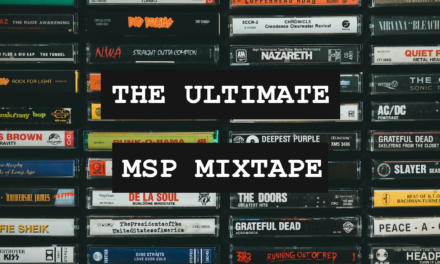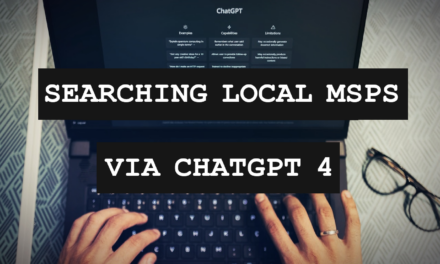9 Simple Steps To Create An IT Sales & Marketing Plan
Creating a marketing plan for your Managed Services business can be a daunting task. This is mostly because of the perception that most people have about what a marketing plan is and how much information it should contain. The truth is, the perfect marketing plan doesn’t exist. A lot of what is documented in your initial plan doesn’t work out as anticipated or needs to be adjusted as results are discovered. So why spend so much time up-front planning? The truth is, you shouldn’t.
Instead, you should spend 5 minutes jotting down each of the the answers to these basic questions and update them as often as possible. Your strategies should evolve as you learn more about your prospect, their behaviors on different platforms, and what makes them buy. Use your marketing plan as an “idea log” to document your finding and what you think you should do next. Then look to execute whatever is documented until you reach a pivot point. Doing so will ensure that your valuable time is not wasted and your documentation is always current.
What products or services are you going to sell?
The first step in this process is to identify what it is that you want to sell. This can be your loss leader services, a differentiating product, a basic Managed Services contract, or a bundled combination of all of the above. It is important to document this step so that you can better concentrate on who your prospective buyers will be.
By establishing your core product offering for this particular marketing plan, you should be able to calculate what the lifetime value of the customer will be once you acquire them. This will give you a good estimate of what your target acquisition cost should be as you begin to spend money on marketing activities. Your primary objective should be to sell this one particular offering and all of your answers to the next 8 questions should be a reflections of that goal.
Who is most likely to buy your products or services?
After focusing in on your products and services, you can now identify who is the best fit to purchase them. In today’s digital landscape, you need to create a hyper-contextual experience for your target if you want to a good return on ad spend. This means creating a unique experience for your audience based on their individual demographics. To achieve this, first document each of the following characteristics that you believe is a fit for your offering:
- Geographic Area (i.e. NYC+50 miles)
- Industry Vertical (i.e. Legal)
- Company Size (i.e. 10-150 employees)
- Job Title (i.e. President, Managing Partner, Managing Attorney)
Focusing on one vertical at a time will allow you to create a more effective strategy. This process can simply be repeated from beginning to end if you wish to target more than one vertical.
The Ultimate Guide To Cash Flow For Managed Services
Sponsored by Alternative Payments & Zest
How will they enter your marketing funnel?
The laziest way to build a target audience for the top of your funnel is to buy a list of contacts. Business-to-business data that is generated using “white hat” techniques is readily available, but you often get what you pay for. This can be used to supplement your earned audience, but relying solely on purchased data is not the best way to go.
When looking to capture new audiences into your funnel, it is best to reverse engineer your target’s attention. Put yourself in their shoes and think about what it is they do on a day-to-day basis and where their attention might lie as they do it. This is likely a combination of platforms or publications from which they feed on information for their professional and personal benefit.
Using our previous examples of the legal industry, here is what a short list of placements might look like:
- LinkedIn Ads
- Reddit (i.e. r/law)
- Youtube (i.e. Law & Crime Network)
- Google Display (i.e. Law.com)
What mediums will you use to get their attention?
If you are going to leverage ad networks such as the ones listed above, you will need creative to do so. This is what grabs your audience’s attention as they are scrolling their social feed, browsing the web, or reviewing their inbox.
There are several different mediums that can be used for each platform, so look to first select the ones that appear to be the most natural fit. Keep in mind that you may discover that some ads or mediums are showing much better results than others. You should always be creating and testing new creative as there is always room for improvement. Just be sure to update your plan with your pivots as you go.
Here are a few examples of mediums that can be used to reach your audience:
- Email Template
- Video Content
- Banner Ad
- Text / Image
How will you deliver them value immediately?
After you have gotten your audience’s attention, you should look to immediately provide them something of value. This is where you begin to shape your message into something that the audience can consume with very little friction. Figuring out your audience’s interests and frustrations is a great start in creating this deliverable. Once you have an idea of the problems your audience is facing, you can attract their attention by offering the solution and asking for nothing in return. The best way to do this is through some type of gated asset, whether it’s a deck, e-book, video course, tool, or template.
For this section of your marketing plan, jot down some ideas of informative topics that you think will be most beneficial to your audience. The more relatable the topic is, the more it will strike a chord with your audience and make them open to further communication.
To give you a general idea, here are a few deliverable ideas that could be used for our ongoing example of the legal industry.
- How To Keep Your Case Files and Client Info Secure
- Choosing Case Management Software: On-Premise vs Cloud
- Ways To Stop Losing Billable Hours To Technology Issues
The Ultimate Guide To Cash Flow For Managed Services
Sponsored by Alternative Payments & Zest
How will you nurture the relationship?
When someone truly finds value in your content, they will opt-in, follow, or revisit in search for more. While they may not have a need for your service at this exact moment in time, it is your job to keep them engaged until their need arises. This is what is referred to as “nurturing.”
Nurturing your prospect can be done in many different ways. The goal throughout the nurturing period is to remain relevant and continue providing more value over time to build trust from a distance. If you are able to do this successfully, prospects will come to you on an inbound basis when they decide the time is right.
Here are a few examples of ways to nurture your prospects that you may look to include in your marketing plan:
- Email Newsletter or Drip Campaign
- Routine Social Media Posts
- Display Retargeting
How will you know when they are ready to buy?
The next step is to create a clear buying path for your prospect to take when they are ready. This often begins in the form of a landing page opt-in form or appointment scheduling system that allows them to signal their interest and make direct contact with you at their convenience.
Different prospects might show interest during various stages of the nurturing process, so be sure that every point of contact has a clear call-to-action for them to take, should they decide they ready to take the next step. This call-to-action should be prominent, but should not get in the way of them consuming your valuable content.
For this part of your marketing plan, document each of your points of contact, such as follows:
- Website Opt-In Form
- Email Reply
- Inbound Call
- Calendar Appointment
How will you convert them to a paying customer?
When your prospect makes contact with you, it is important to always know when the next step should be on their buying journey. Most often in the IT Industry there is a free consultation that is used for discovery and qualifying purposes. If there is mutual interest beyond this point, a quote will be sent to the prospect and then it will be followed up on either manually or automatically until the prospect accepts or declines.
For this section of your marketing plan, simply outline the steps required to take your prospect from inbound to on-boarding. It is important that this process be streamlined as best as possible and a standard is documented to hold your sales & marketing teams accountable. Establish rules for follow-ups that need to be met and write out the frequency of your automated workflows. If you find this to be too much or not enough follow-up, simply adjust as you go and keep updating your plan as you feel appropriate.
How will you increase their value over time?
The final piece of your marketing plan is to outline how you expect to increase the value of your customer during the period that you retain them. Existing customers are going to be much more likely to buy from you than anyone else. Some businesses often forget this and spend the majority of their time chasing net-new business when they have high converting sales opportunities right under their nose.
Create a list of each method you will use to market to your existing customers. Much like the nurturing process, this is really just a way to keep your customer informed about what else you can offer them and why it is a good fit for their business.
Here are a few examples of ways you might continue your marketing process to increase the value of your customer over time:
- Routine Email Newsletter
- Frequent Client Meetings / Calls
- Display Ads Using Matched Audiences
Executing this part of the overall strategy can make a significant impact on your marketing return on investment and creates better cash flow that can be reinvested into the beginning of your funnel.

SPONSORED BY ZEST

















